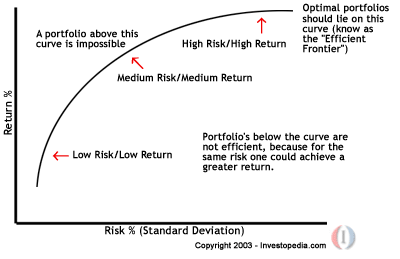Why construct a portfolio? Consider this: you own one mutual fund with a large allocation of stock - say 10% of the portfolio – in stock of Marvel (NYSE: MVL). Then they release Ghost Rider. After Fantastic Four, Daredevil, and Punisher, investors realize that there may not be in for profits in the near future. After all, how many more Spider-Man and X-Men movies can they make? The stock plummets and you’re out 10% of you investment. To prevent this, investment professionals recommend a portfolio of mutual funds that use difference investment types to achieve returns. If you held 50% in one other mutual fund that didn’t own Marvel stock, you would only have lost 5% of your investment.
Conversely, if you owned only Marvel and its price doubled, you would double your money. However, this is called gambling, and I do not endorse it.
In school one of the first things they teach you is about the efficient frontier. The efficient frontier is a curve that looks like a hill, and represents that for each level of risk there is a corresponding portfolio composition that maximizes expected returns. If you are not on the curve, you are taking on either too much or too little risk for a given level of expected return.

The optimal portfolios plotted along the curve have the highest expected return possible for the given amount of risk. However, the curve changes depending on the investments available and the market conditions. So, how much do you invest in a given type of investment?
First, you need to determine your risk tolerance. Risk tolerance is the degree of uncertainty that an investor can handle in regards to a negative change in the value of their portfolio. Calculators vary widely such as the following one from fincalc.com. However, nobody wants to compute your risk tolerance for you and give you an optimal asset allocation (such as 40% stock, 40% bonds, 10% international, 10% cash) because doing so is a liability. This is why full-service brokers and advisors charge a fee. If you can determine your own asset allocation and understand basic investments, you can avoid fees by using a discount broker. I advise you to avoid the fees by doing a little homework.
1: Visit a website that will help you determine your risk tolerance. Just Google it.
2: Buy asset types in accordance with the risk tolerance, i.e. higher risk (equities) for a higher risk tolerance and more bonds for a lower risk tolerance. The easy way around constructing your own asset allocation, is to simply buy a fund-of-funds with your risk tolerance in mind, or to use them as an example. I use a proprietary asset allocation model from a prior employer (so I cannot share it), but you can construct a portfolio based on a balanced fund, such as Vanguard Wellesley (VWINX), which is conservative with 60% bonds and 40% stocks. You could also just buy a conservative fund if you happen to have a conservative risk tolerance (if you're under 40, you should not buy a conservative fund; you should at least purchase a moderate if not aggressive fund).
3: An alternative: buy a target date fund. It's like a heat-seeking missile, you fire and forget. Retiring in 2050? Buy a 2050 fund like the Principal fund (PZASX). Invest regularly and you never have to worry about investment mix or adjusting your portfolio, that's what a manager's for!
Whatever you buy, particularly if you're new at it, it will take time to become comfortable investing in an asset that may lose value. Even after you've made a profit, seeing the value decline on certain days or months takes stomach. So give it time.
Next Issue: Dollar-cost averaging
Next next issue: Selecting a financial service